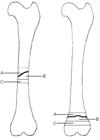Abstract
The aim of the present study was to perform the macroscopic and microstructural morphological classification of long bone fractures of Cerdocyon thous. Eighteen cadavers of the species were necropsied, and subjected to radiographic and microscopical evaluation when long bone fractures were detected. Among the 18 cadavers, eight (44%) had fractures equally distributed (33.33%) in the femur, humerus, or tibia. More frequently (61.54%), the fractures were simple and affected the diaphysis, and in smaller proportions (23.08%) reached the physeal line. In diaphyseal and metaphyseal fractures, microscopical evaluation revealed cortical bone tissue, with longitudinal osteons that contained longitudinal and intermediate collagen fibres and lamellae with a delamination aspect. On the other hand, in epiphyseal fractures, trabecular bone tissue was more frequently observed, consisting of trabeculae with disorganised collagen fibres and absence of osteons. In both cases low activity, osteocytes, and low coverage of osteoblasts on the bone surface were noted. It was concluded that the frequency of fractures in the long bones of C. thous was 44%, with females being more predisposed. The findings support the hypothesis that fractures in such animals are caused by being run over by automobiles. The present study contributes significantly in alerting clinicians and surgeons to the types of fractures that C. thous is more predisposed to, its places of greatest occurrence, and its microstructure. Thus, there is a need for joint actions aimed at reducing the number of cases of wild animals being run over by automobiles.
Keywords:
Bone biology; Orthopaedics; Run-over accidents; Trauma

 Thumbnail
Thumbnail
 Thumbnail
Thumbnail
 Thumbnail
Thumbnail
 Thumbnail
Thumbnail
 Thumbnail
Thumbnail




